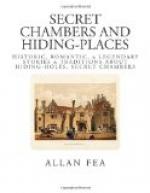In the year 1861 a hidden receptacle was found at the Elizabethan college of Wedmore, Kent, containing Roman Catholic MSS. and books; and at Bromley Palace, close by, in a small aperture below the floor, was found the leathern sole of a pointed shoe of the Middle Ages! Small hiding-places of this nature existed in a wing, now pulled down, of the Abbey House, Whitby (in “Lady Anne’s Room"). At Castle Ashby, Northants; Fountains Hall, near Ripon; Ashes House, near Preston; Trent House, Somerset; and Ockwells, Berks,[1] are panels opening upon pivots and screening small cavities in the walls.
[Footnote 1: Another hiding-place is said to have existed behind the fireplace of the hall.]
[Illustration: HURSTMONCEAUX CASTLE, SUSSEX]
CHAPTER XV
HIDING-PLACES OF SMUGGLERS AND THIEVES
Horsfield, in his History of Sussex, gives a curious account of the discovery in 1738 of an iron chest in a recess of a wall at the now magnificent ruin Hurstmonceaux Castle. In the thickness of the walls were many curious staircases communicating with the galleries. When the old castle was allowed to fall into ruin, the secret passages, etc., were used by smugglers as a convenient receptacle for contraband goods.
Until recently there was an ingenious hiding-place behind a sliding panel at the old “Bell Inn” at Sandwich which had the reputation of having formerly been put to the same use; indeed, in many another old house near the coast were hiding-places utilised for a like purpose.
In pulling down an old house at Erith in 1882 a vault was discovered with strong evidence that it had been extensively used for smuggling. The pretty village of Branscombe, on the Devonshire coast, was, like the adjacent village of Beer, a notorious place for smugglers. “The Clergy House,” a picturesque, low-built Tudor building (condemned as being insecure and pulled down a few years ago), had many mysterious stories told of its former occupants, its underground chambers and hiding-places; indeed, the villagers went so far as to declare that there was another house beneath the foundations!




